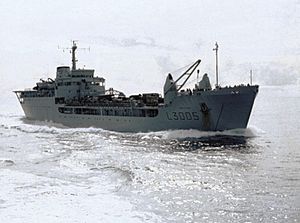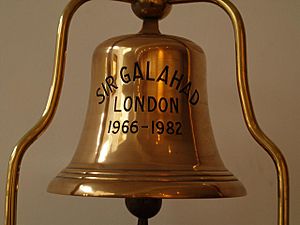RFA Sir Galahad (1966) facts for kids
RFA Sir Galahad (L3005) was a special kind of ship called a Landing Ship Logistics (LSL). It belonged to the Royal Fleet Auxiliary of the United Kingdom. These ships are designed to carry troops, vehicles, and supplies to land on beaches during military operations.
The Sir Galahad became well-known during the Falklands War in 1982. On June 8, it was bombed and caught fire at a place called Fitzroy.

RFA Sir Galahad in 1982
|
|
Quick facts for kids History |
|
|---|---|
| Namesake | Galahad |
| Builder | Alexander Stephen and Sons |
| Laid down | February 1965 |
| Launched | 19 April 1966 |
| Commissioned | 17 December 1966 |
| Identification | IMO number: 6615508 |
| Fate |
|
| General characteristics | |
| Class and type | Round Table class LSL |
| Tonnage |
|
| Displacement |
|
| Length | 412 ft (126 m) |
| Beam | 60 ft (18 m) |
| Draught | 13 ft (4.0 m) |
| Propulsion |
|
| Speed | 17 knots (31 km/h) |
| Range | 9,200 nautical miles (17,040 km) at 15 knots (28 km/h) |
| Capacity | 2,443 tonnes |
| Complement | 68 crew, up to 534 passengers |
| Armament | Two 40 mm Bofors AA guns. |
| Aircraft carried | Up to 20 Wessex helicopters (1973) |
Contents
What Was the RFA Sir Galahad?
The Sir Galahad was first managed by the British-India Steam Navigation Company for the British Army. In 1970, it was transferred to the Royal Fleet Auxiliary (RFA). Its crew was made up of civilian sailors from Hong Kong.
Building and Design
The Sir Galahad was a 3,322-tonne LSL ship. It was built by Stephens and launched in 1966. The ship was designed to carry a lot of cargo. It could hold 340 troops, or even 534 for short trips.
For cargo, it could carry 16 light tanks and 34 other vehicles. It also had space for 122 tonnes of fuel and 31 tonnes of ammunition. The ship used three cranes to unload its cargo.
Helping Others: Operation Burlap
In late 1970, the Sir Galahad took part in a mission called Operation Burlap. This was a humanitarian mission to help East Pakistan after a terrible cyclone. The storm caused a lot of damage and flooding. The ship helped by bringing aid and supplies to the people who needed it.
The Falklands War: A Difficult Time
The Sir Galahad was part of the British forces during the Falklands War in 1982. It sailed from HMNB Devonport on April 6, 1982, carrying 350 Royal Marines.
The First Attack
On May 21, the ship arrived at San Carlos Water in the East Falkland Islands. Three days later, on May 24, the Sir Galahad was attacked. Skyhawk and IAI Dagger aircraft from the Argentine Air Force attacked it.
One bomb, weighing 1,000 pounds (450 kg), hit the ship but did not explode. The ship was also hit by cannon fire from the Daggers. Brave Royal Marine volunteers helped a Royal Navy team remove the unexploded bomb. They carefully carried it to the back of the ship. The bomb was then placed in an inflatable boat filled with cornflakes for padding. The boat was taken into San Carlos water, where it was sunk.
After the bomb was removed, the ship continued its work. It carried supplies to Teal Inlet along with another ship, RFA Sir Percivale.
The Second Attack and Loss
On June 8, the Sir Galahad was preparing to unload soldiers from the Welsh Guards. This was happening in Port Pleasant, Fitzroy. Another ship, RFA Sir Tristram, was also there.
Around 2:00 PM local time, three Skyhawk planes attacked the ships. Each plane carried three 500-pound (227 kg) bombs. The Sir Galahad was hit by two or three bombs. These bombs exploded and started large fires. The explosions and fires sadly caused the deaths of 48 crew members and soldiers.
Heroes and Rescue Efforts
After the air attack, the fires on the ship quickly grew out of control. The ship's Royal Marine team bravely organized the rescue of the injured. They helped launch life rafts from the front of the ship. At the same time, they guided helicopters to winch survivors to safety. First aid was given to those who were most seriously hurt.
BBC television cameras showed images of Royal Navy helicopters flying through thick smoke. They were rescuing people from the burning ships.
Chiu Yiu-Nam, a sailor on the Sir Galahad, was later given the George Medal. He earned it for rescuing ten men who were trapped by a fire deep inside the ship. The ship's captain, Philip Roberts, was reportedly the last person to leave the Sir Galahad. He received the DSO for his strong leadership and courage. Royal Marine Sergeant Brian Dolivera was also recognized for his help in the evacuation.
Remembering the Sir Galahad
On June 21, the damaged ship was towed out to sea by the RMAS Tug Typhoon. It was then sunk by the submarine HMS Onyx using torpedoes. The wreck of the Sir Galahad is now an official war grave. This means it is a protected place under the Protection of Military Remains Act.
Guardsman Simon Weston was one of the survivors of the attack on the Sir Galahad. He suffered serious burns. His story has been shared widely in the news. Ten years after the Sir Galahad sank, Weston was awarded the OBE.
A new ship with the same name and number entered service in 1988.
See also
 In Spanish: RFA Sir Galahad (1966) para niños
In Spanish: RFA Sir Galahad (1966) para niños


